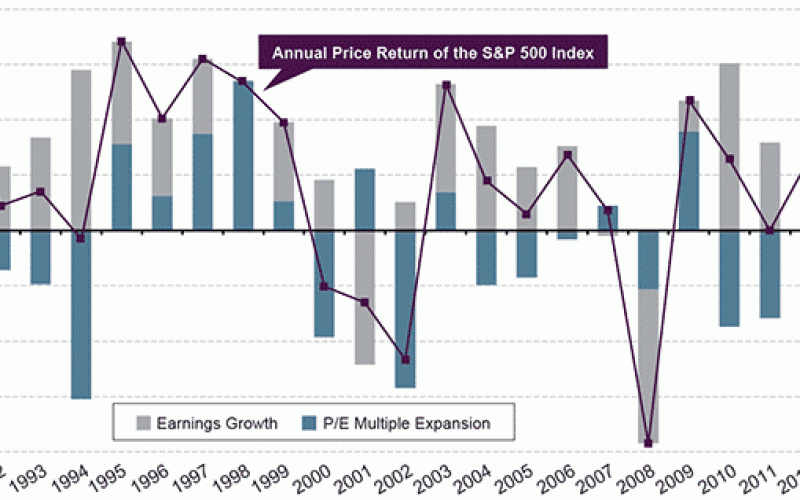My long-term view of U.S. equities remains bullish, but a number of indicators, as well as near-term macro challenges, point to a pause in the run-up of that asset class.
by Scott Minerd, CIO, Guggenheim Partners LLC
Winding the clock back to the fall of last year, it was clear that U.S. equities, and financial stocks in particular, were a strong buy and warranted increased allocations where appropriate. I gave a top-end target estimate of around 1720 for the S&P 500 at the time. Today, my long-term view of U.S. equities remains bullish, and U.S. equities could easily be 30-40 percent higher than today’s levels within two to three years. Having said that, for a number of reasons, now does not appear to be a favorable entry point. Depending on their time-horizons, investors, many who have large unrealized gains, may want to consider booking some of those gains and reducing their equity exposure.
Historically, markets that have rallied as aggressively as U.S. equities since November 2012 (an increase of 25 percent), pause or correct to digest their advances. Also, earnings among U.S. companies have flattened and could turn negative within two to three quarters, meaning further upside can only come from multiple expansion. Of the 19 percent rise in stocks year-to-date, 16 percent has already come from multiple expansion. Finally, it appears GDP growth could be entering a soft patch as we work through a number of short-term issues such as the headwinds in housing, reduced growth in China, the full impact of the sequester, and the budget and debt ceiling debates that will take place in Washington in the third quarter – all of which will put downward pressure on stock prices. The near-term outlook for equities makes now a good time to consider the old Wall Street adage, “Nobody ever lost money by taking a profit."
Chart of the Week
Multiple Expansion Driving the Rally in U.S. Equities
The P/E multiple, defined as the ratio of price to trailing 12-month earnings, has been the main driver of the rally in U.S. equities over the past two years. The S&P 500 index has increased by over 34 percent since the beginning of 2011, of which 28 percent has come from multiple expansion. During the same period, growth in corporate earnings has slowed. The trailing 12-month earnings for S&P 500 companies rose 2.4 percent in 2012 and another 2.5 percent for the first seven months of this year, registering the slowest earnings growth in non-recession years since 1998. Without renewed earnings growth, a continued rally in stocks driven by multiple expansion may be not sustainable.
S&P 500 RETURN AND THE BREAKDOWN OF CONTRIBUTION

Source: Bloomberg, Guggenheim Investments’ Calculation. Data is annual frequency with latest 2013 data updated as of 8/7/2013.
Economic Data Releases
Mixed U.S. Data Weak with Strong ISM and a Weak Jobs Report
- Non-farm payrolls rose a less-than-expected 162,000 in July, with June and May payrolls revised down by a combined 26,000.
- The unemployment rate fell to 7.4% in July, the lowest level of the recovery.
- Average hourly earnings decreased 0.1%, the first decrease since October 2012.
- Average weekly hours ticked down to 34.4, the first decrease in four months.
- Initial jobless claims fell last week to a post-recession low of 326,000.
- The ISM manufacturing index jumped in July from 50.9 to 55.4, the highest level in two years.
- The ISM non-manufacturing index rebounded in July to 56.0, the fastest expansion in five months.
- Construction spending contracted 0.6% in June after rising the previous two months.
- The U.S. trade deficit narrowed to -$34.2 billion in June, the smallest deficit since October 2009. Exports were up 2.2% to a record high, while imports fell 2.5%.
More Positive Data Out of Europe
- The euro zone manufacturing PMI increased to 50.3 in July, returning to expansionary territory for the first time in two years.
- Euro zone retail sales declined slightly less-than-expected in June, down 0.5%, the first decrease since March.
- Italy’s GDP shrank 0.2% in the second quarter, the slowest pace of contraction in seven quarters.
- German industrial production jumped 2.4% in June, the fastest monthly increase since July 2011.
- German factory orders were up 3.8% in June, an eight-month high.
- Industrial production in the U.K. rose 1.1% in June, the best month since July 2012.
- The U.K. manufacturing PMI for July climbed to 54.6, the best since March 2011.
- China’s official manufacturing PMI ticked up to 50.3 in July, while the HSBC PMI remained in contraction at 47.7.
- The HSBC services PMI in China stayed flat at 51.3 in July, with the official PMI showing faster expansion.
- Japan’s monetary base expanded 38% from a year earlier in July, the fastest pace in 40 years.















